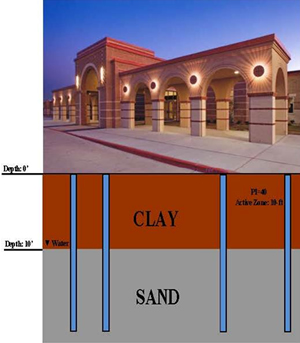

Webmaster: Stansfeld, LLC. |
|
|

FEBRUARY 2014 MEETING
Wednesday, February 12, 2014 (1.5 PDH)
TECHNICAL PROGRAM
Simplified Method for Design of Shallow Drilled Shafts, Subject to Light Loading in Expansive Soils.
Speaker: David Eastwood, P.E., C.A.P.M. Founder Geotech Engineering and Testing and Co-founder of the Foundation Performance Association.
PRESENTATION SUMMARY
 To an audience of 70 attendees, David Eastwood presented information for the simplified design of drilled shafts subject to lightly loaded structures. All aspects of drilled pier design were discussed including the definition of soil suction, uplift resistance, and the methodology of active zone evaluation. Numerous case histories were illustrated followed by the series of demonstration calculations. The same methods presented were noted to be viable and applicable to other types of piers such as helical piles, etc.
To an audience of 70 attendees, David Eastwood presented information for the simplified design of drilled shafts subject to lightly loaded structures. All aspects of drilled pier design were discussed including the definition of soil suction, uplift resistance, and the methodology of active zone evaluation. Numerous case histories were illustrated followed by the series of demonstration calculations. The same methods presented were noted to be viable and applicable to other types of piers such as helical piles, etc.
Many drilled footings are designed and constructed improperly in Texas without proper knowledge of treatment for expansive soils. The design of drilled footings in expansive soils should be designed to satisfy two criteria; one is the end bearing and the other uplift resistance. The drilled footings should be founded in a strong soil stratum with adequate bearing capacity. Furthermore, the depth of drilled footings should also be determined such that the uplift along the pier shafts is resisted by the skin friction below the zero movement line. Mr. Eastwood will present an algorithm that was developed that illustrates the design procedures for calculating the proper pier depth to resist upward loading using conventional geotechnical soils data to design these drilled footings. The method is used predominately for lightly structure subject to light loads such as residential and light commercial projects in expansive soils. Usually these structures have column loads of less than 50 kips.
Some of the key points that were made in the presentation are:
- Three case histories were described where lightly loaded structures were affected by uplift due to expansive soils and shallow drilled piers. Essentially, these foundation systems, which consist of structural slabs on piers, acted more like a floating slab system because the piers were placed within the active zone.
- Mr. Eastwood describes methodology of how to evaluate the active zone (depth of constant suction). Various conditions were illustrated where limits of the active zone could be identified. Some of these conditions consisted of depths at which one hits sand or rock. The active zone also is defined by depths where the soil Liquid Index (LI) becomes unchanging. Also, where the soil suction changes as a function of depth and soil suction is less than 0.027 pF defines the depth of the active zone. Slickensides may be encountered at the bottom interface of the active zone. Other factors that define the active zone may be the depth of historical groundwater, etc.
- Other factors presented that may affect the soil suction of a site are areas where native trees exist, where trees are planted, where trees are removed, and the presence of sand, rock, etc.
Mr. Eastwood has developed solutions on how to calculate uplift resistant due to expansive soils. Mr. Eastwood discussed various soil conditions in the United States, Texas and Houston. Mr. Eastwood presented an algorithm and calculations defining the depth of zero movement line and anchoring depth of drilled piers. Equations were presented that described uplift loads due to expansive soils using swell pressures. The depth of active zone and equations were also presented illustrating how to anchor drilled shafts in expansive soils and how to calculate the anchoring resistance. Three examples illustrating the information above were presented. One example consisted of an all clay profile the other two consisted of having clay over sand layers.
In conclusion, Mr. Eastwood presented a simple rule of thumb for structural engineers to use when evaluating soil reports and as they relate to pier depths in the areas that have expansive soils.
To read summaries of previous FPA presentations by David Eastwood, please click:
September 2007 - Recommended Practices for Design and Construction of Swimming Pools in Houston
January 2003 ASCE Paper Presentation - "Recommended Practice for the Design of Residential Foundations."
June 2001 - State of Practice of Geotechnical Engineering Design of Custom Homes in the Houston Area between 1990 and 2001
|



